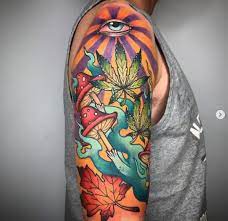Trippy stoner tattoos represent more than just ink on skin; they embody a culture deeply rooted in artistic expression and individuality. Emerging from the counterculture movements of the 1960s and ’70s, these tattoos are a visual kaleidoscope, offering a glimpse into a world where fantasy and psychedelia converge. In this article, we delve into the history, symbolism, artistic elements, societal impact, and debates surrounding these mind-bending tattoos that resonate with free spirits and those seeking self-expression.
The Psychedelic Roots: 1960s and ’70s Counterculture
Trippy stoner tattoos find their origins in the counterculture movements of the 1960s and ’70s. Fueled by the use of psychedelic drugs like LSD and marijuana, this era was characterized by a yearning for liberation, peace, and exploration. These mind-altering substances were believed to expand consciousness and open doors to new perceptual dimensions. Inspired by the vivid visions experienced during altered states of consciousness, artists began creating tattoos that captured the essence of these psychedelic experiences, using vibrant colors, intricate patterns, and mind-expanding imagery.
Symbolism and Significance
Trippy stoner tattoos hold profound meaning for those who choose to adorn their bodies with them. Each component, color, and pattern tells a story of the wearer’s journey through life and spiritual growth. Symbolism often revolves around transcendental experiences, personal development, and the interconnectedness of all life. Common motifs like mandalas, sacred geometry, cosmic landscapes, and fantastical creatures represent unity, balance, and a celebration of individualism.
Artistic Expression: Pushing Creative Boundaries
Trippy stoner tattoos offer a unique opportunity for both tattoo artists and enthusiasts to explore the boundaries of creativity and imagination. The artistic process involves a close collaboration between the artist and the client, incorporating techniques such as color mixing, precise linework, and abstract compositions. Through this unique form of expression, tattoo aficionados can exhibit their inner thoughts and emotions on their skin, creating wearable works of art that mesmerize and inspire.
Impact on Culture and Society
Trippy stoner tattoos have transcended their counterculture roots to become a recognized and influential art form. Today, they are widely accepted across various societal segments, breaking down stigmas and preconceived notions associated with tattoos. This art form has become an integral part of contemporary tattooing, with artists infusing psychedelic elements into other tattoo subgenres, creating a fusion of styles that appeal to diverse personal interests.
Debating Trippy Stoner Tattoos
Despite their growing popularity, trippy stoner tattoos have sparked debates. Some critics worry that these tattoos could glorify drug use or reinforce negative stereotypes. However, supporters argue that these tattoos celebrate individuality and self-expression, encouraging people to embrace their true selves without fear of judgment. It is essential to understand the motivations behind obtaining psychedelic stoner tattoos and engage in meaningful dialogue to appreciate the diverse perspectives on this art form.
Conclusion: A Window to the Psychedelic Soul
Trippy stoner tattoos are more than mere body art; they are gateways to the hearts and minds of their bearers. These captivating images evoke emotions, prompt contemplation, and pay homage to the wonder of human imagination. Whether one embraces the psychedelic experience or admires the artwork, trippy stoner tattoos undeniably leave a lasting impression on both the canvas of the skin and the canvas of the mind. They provide free spirits and those seeking the extraordinary an opportunity to carry a piece of the enchanted and bizarre world with them wherever they go.





